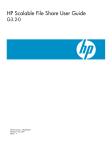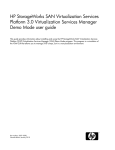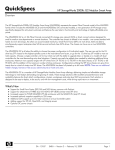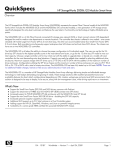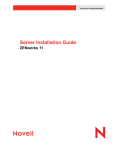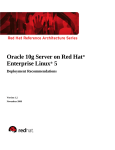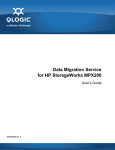Download Red Hat ENTERPRISE LINUX 4 - DM MULTIPATH Technical data
Transcript
Installation and Reference Guide
Device Mapper Multipath Enablement Kit for
HP StorageWorks Disk Arrays
Version 4.0.0
Part number: AA-RW8RD-TE
First edition: February 2008
© Copyright 2008 Hewlett-Packard Development Company, L.P.
Confidential computer software. Valid license from HP required for possession, use or copying. Consistent with FAR 12.211 and
12.212, Commercial Computer Software, Computer Software Documentation, and Technical Data for Commercial Items are licensed
to the U.S. Government under vendor’s standard commercial license.
The information contained herein is subject to change without notice. The only warranties for HP products and services are set forth
in the express warranty statements accompanying such products and services. Nothing herein should be construed as constituting
an additional warranty. HP shall not be liable for technical or editorial errors or omissions contained herein.
Red Hat is the registered trademark of Red Hat, Inc.
SuSE is the registered trademark of Novell, Inc.
Contents
About this guide
. . . . . . . . . . . . . . . . . . . . . . . . . .
Intended audience . . . . . . . . . . .
Document conventions and symbols . . .
HP technical support . . . . . . . . . .
Helpful websites . . . . . . . . . . . .
.
.
.
.
.
.
.
.
.
.
.
.
.
.
.
.
.
.
.
.
.
.
.
.
.
.
.
.
.
.
.
.
.
.
.
.
.
.
.
.
.
.
.
.
.
.
.
.
.
.
.
.
.
.
.
.
.
.
.
.
.
.
.
.
.
.
.
.
.
.
.
.
.
.
.
.
.
.
.
.
.
.
.
.
.
.
.
.
.
.
.
.
.
.
.
.
.
.
.
.
.
.
.
.
1 Introduction to HPDM Multipath . . . . . . . . . . . . . . . . . . .
Overview . . . . . . . .
Features . . . . . . . .
What’s New . . . .
Software Components . .
HPDM Multipath Operation
.
.
.
.
.
.
.
.
.
.
.
.
.
.
.
.
.
.
.
.
2 Installing HPDM Multipath
.
.
.
.
.
.
.
.
.
.
.
.
.
.
.
.
.
.
.
.
.
.
.
.
.
.
.
.
.
.
.
.
.
.
.
.
.
.
.
.
.
.
.
.
.
.
.
.
.
.
.
.
.
.
.
.
.
.
.
.
.
.
.
.
.
.
.
.
.
.
.
.
.
.
.
.
.
.
.
.
.
.
.
.
.
.
.
.
.
.
.
.
.
.
.
.
.
.
.
.
.
.
.
.
.
.
.
.
.
.
.
.
.
.
.
.
.
.
.
.
.
.
.
.
.
.
.
.
.
.
.
.
.
.
.
.
.
.
.
.
.
.
.
.
.
. . . . . . . . . . . . . . . . . . . . .
HPDM Multipath Support Matrix . . . . . .
Prerequisites for HPDM Multipath Installation .
Installing/Upgrading HPDM Multipath Tools .
Setting up HPDM Multipath . . . . . .
Configuring QLogic HBA Parameters
Configuring Emulex HBA Parameters
.
.
.
.
.
.
.
.
.
.
.
.
.
.
.
.
.
.
.
.
.
.
.
.
.
.
.
.
.
.
.
.
.
.
.
.
.
.
.
.
.
.
.
.
.
.
.
.
.
.
.
.
.
.
.
.
.
.
.
.
.
.
.
.
.
.
.
.
.
.
.
.
.
.
.
.
.
.
.
.
.
.
.
.
.
.
.
.
.
.
.
.
.
.
.
.
.
.
.
.
.
.
.
.
.
.
.
.
.
.
.
.
.
.
.
.
.
.
.
.
.
.
.
.
.
.
.
.
.
.
.
.
.
.
.
.
.
.
.
.
.
.
.
.
.
.
.
.
.
.
.
.
.
.
.
.
.
.
.
.
5
5
5
6
6
7
7
7
7
8
8
9
9
10
. 11
. 11
. 11
12
3 Configuring HPDM Multipath . . . . . . . . . . . . . . . . . . . .
13
4 Using HPDM Multipath . . . . . . . . . . . . . . . . . . . . . .
19
Using /etc/multipath.conf File . . . . . . . . . . . . . . . . . . . . . . . . . . . . . . . .
Starting HPDM Multipath . . . . . . . . . . . . . . . . . . . . . . . . . . . . . . . . . .
Creating an Alias using /etc/multipath.conf file . . . . . . . .
Using Multipath Map . . . . . . . . . . . . . . . . . .
Path Grouping . . . . . . . . . . . . . . . . . .
Clustering Solutions with HPDM Multipath . . . . . . . . . . .
Configuring HP Service Guard with HPDM Multipath Devices .
Configuring SteelEye LifeKeeper with HPDM Multipath Devices
5 Removing HPDM Multipath Tools
.
.
.
.
.
.
.
.
.
.
.
.
.
.
.
.
.
.
.
.
.
.
.
.
.
.
.
.
.
.
.
.
.
.
.
.
.
.
.
.
.
.
.
.
.
.
.
.
.
.
.
.
.
.
.
.
.
.
.
.
.
.
.
.
.
.
.
.
.
.
.
.
.
.
.
.
.
.
.
.
.
.
.
.
.
.
.
.
.
.
.
.
.
.
.
.
13
17
19
19
21
22
22
23
. . . . . . . . . . . . . . . . .
25
6 Troubleshooting . . . . . . . . . . . . . . . . . . . . . . . . .
27
7 Abbreviations . . . . . . . . . . . . . . . . . . . . . . . . . .
29
Removing HPDM Multipath Tools . . . . . . . . . . . . . . . . . . . . . . . . . . . . . . .
Device Mapper Multipath Enablement Kit for HP StorageWorks Disk Arrays
25
3
Tables
1 Document conventions . . . . . . . . . . . . . . . . . . . . . . . . . . . . . . .
5
2 Hardware and Software Prerequisites
9
. . . . . . . . . . . . . . . . . . . . . . . .
3 HP Recommended configuration parameters
4
. . . . . . . . . . . . . . . . . . . .
14
4 Basic operations of HPDM Multipath . . . . . . . . . . . . . . . . . . . . . . . .
22
5 Abbreviations
29
. . . . . . . . . . . . . . . . . . . . . . . . . . . . . . . . .
About this guide
HP Device Mapper Multipath (HPDM Multipath) software kit is an HP released Device Mapper multipath
binary based on Device Mapper included in Linux operating system distributions with enablement for
HP StorageWorks Disk Arrays. This guide describes the Device Mapper multipath enablement for HP
StorageWorks Disk Arrays (HPDM Multipath) and provides information to help you:
•
•
•
•
•
Determine hardware and software prerequisites
Install HPDM Multipath
Configure HPDM Multipath
Use HPDM Multipath
Troubleshoot HPDM Multipath
NOTE:
This version of HPDM Multipath supports all the features available in the earlier versions. It also supports a
range of new features and OS. For more information, see What's New.
Intended audience
This document is intended for users who install, configure, and manage HPDM Multipath in their Linux
server environment. Readers must be familiar with Linux system administration, including hardware
and software installation.
Document conventions and symbols
Table 1 Document conventions
Convention
Element
Medium blue, underlined text
(http://www.hp.com)
Website addresses
Bold font
• Key names
• Text typed into a GUI element, such as into a box
• GUI elements that are clicked or selected, such as menu and list items,
buttons, and check boxes
Italic font
Text emphasis
Monospace font
•
•
•
•
Monospace, italic font
• Code variables
• Command-line variables
Monospace, bold font
Emphasis of file and directory names, system output, code, and text
typed at the command line
File and directory names
System output
Code
Text typed at the command line
Device Mapper Multipath Enablement Kit for HP StorageWorks Disk Arrays
5
IMPORTANT:
Provides clarifying information or specific instructions.
NOTE:
Provides additional information.
HP technical support
Telephone numbers for worldwide technical support are listed on the HP support website:
http://www.hp.com/support/
Collect the following information before calling:
•
•
•
•
•
•
Technical support registration number (if applicable)
Product serial numbers
Product model names and numbers
Applicable error messages
Operating system type and revision level
Detailed, specific questions
For continuous quality improvement, calls may be recorded or monitored.
HP recommends that customers sign up online using the Subscriber’s choice website:
http://www.hp.com/go/e-updates
• Subscribing to this service provides you with e-mail updates on the latest product enhancements,
newer versions of drivers, and firmware documentation updates as well as instant access to
numerous other product resources.
• After signing up, you can locate your products by selecting Business support and then Storage
under Product Category.
Helpful websites
For additional product information, see the following websites:
•
•
•
•
•
6
http://www.hp.com/country/us/eng/prodserv/storage.html
http://www.hp.com/support/
http://www.docs.hp.com
http://sourceware.org/dm/
http://download.qlogic.com/drivers/56660/readme_driver_80107.html#driver_parameters
About this guide
1 Introduction to HPDM Multipath
This chapter addresses the following topics:
•
•
•
•
•
Overview
Features
What's New
Software Components
HPDM Multipath Operation
Overview
HPDM Multipath software kit is an HP released Device Mapper multipath binary, based on Device
Mapper Multipath included in Linux Operating System distributions, with enablement for HP
StorageWorks Disk Arrays. Device Mapper is an infrastructure in the Linux kernel. It provides a generic
way to create virtual layers of block devices. It supports striping, mirroring, snapshots, concatenation,
and multipathing. The multipath feature is provided with combination of DM Multipath kernel modules
and multipath-tools user-space package.
Features
nl
HPDM Multipath supports the following features:
• Detects path failure and automatically reroutes (failover) I/O to an available alternate path, if an
existing connection fails.
• Provides an option to perform failback of the LUN to the repaired paths.
• Implements failover or failback actions transparently without disrupting applications.
• Monitors each path and notifies if the path status changes.
• Facilitates I/O load balancing among the multiple paths.
• Provides CLI with display options to configure and manage Multipath features.
• Provides an option to customize names for the HPDM Multipath devices.
• Provides device name persistence across reboots or configuration SAN changes.
• Provides policy-based path grouping for the user to customize the I/O flow through specific set of
paths.
• Provides online LUN addition and deletion support.
• Provides support for the HP StorageWorks Arrays (EVA-AA, MSA-AA, and XP) with latest firmware
revisions.
• Provides multipathing in clustered environment.
• Provides support for multipathing devices to be configured under Logical Volume Manager.
What’s New
HPDM Multipath provides the following additional features as part of this version:
• Provides support for RHEL4.5/RHEL4.6/RHEL5.1/SLES9 SP4 and SLES10 SP1 along with
RHEL5/SLES9 SP3/SLES10 OS distributions.
• Provides support for HP StorageWorks EVA4400 Disk Arrays.
• Provides support for HP StorageWorks MSA1000/1500 Disk Arrays.
• Provides support for HP StorageWorks MSA2000 Product family Disk Arrays
(MSA2012fc/MSA2212fc/MSA2012i).
Device Mapper Multipath Enablement Kit for HP StorageWorks Disk Arrays
7
• Provides support for XP20000/XP24000 Disk Arrays.
• Provides support for EVA iSCSI devices on RHEL5/RHEL5.1/SLES9 SP3/SLES9 SP4/SLES10/SLES10
SP1.
Software Components
This section discusses the following software components of Device Mapper Multipath:
• dm-multipath kernel module -- Routes I/O and provides failover to paths and path groups.
• multipath configuration tool -- Provides commands to configure, list, and flush Multipath devices.
• multipathd daemon -- Monitors path status. When paths revert, multipathd daemon may also
initiate path group switches to ensure that the optimal path group is used.
• kpartx utility -- Reads partition tables on the specified device and creates device maps over
the detected partitions. The kpartx utility is called from hotplug whenever device maps are
created and deleted.
• devmap-name -- Provides a meaningful device name to udev for device maps (devmaps).
HPDM Multipath Operation
HPDM Multipath enables hosts to route I/O over the multiple paths available to an end storage unit
(LUN). A path refers to the connection from an HBA port to a storage controller port. When an active
path through which I/O happens fails, HPDM Multipath reroutes the I/O over other available paths. On
a Linux host, when there are multiple paths to a storage controller, each path appears as a separate
block device and hence results in multiple block devices for single LUN. HPDM Multipath creates a new
Multipath block device for those devices that have the same LUN WWN.
For example, a host with two HBAs when attached to a storage controller with two ports through a
single FC switch provides four block devices: /dev/sda, /dev/sdb, /dev/sdc, and /dev/sdd.
HPDM Multipath creates a single block device, /dev/mapper/mpath1, that reroutes I/O through
these four underlying block devices.
8
Introduction to HPDM Multipath
2 Installing HPDM Multipath
This chapter addresses the following topics:
• HPDM Multipath Support Matrix
• Installing HPDM Multipath Tools
• Setting Up HPDM Multipath
HPDM Multipath Support Matrix
Table 2 lists the hardware and software prerequisites for installing HPDM Multipath.
Table 2 Hardware and Software Prerequisites
System Feature
Operating system versions
Supported hardware and software
Red Hat Enterprise Linux 4 Update 5
Red Hat Enterprise Linux 4 Update 6
Red Hat Enterprise Linux 5 errata 2.6.18–8.1.6.eI5 or later
Red Hat Enterprise Linux 5 Update 1
SuSE LINUX Enterprise Server 9 - Service Pack 3 errata 2.6.5–7.283 or later
SuSE LINUX Enterprise Server 9 - Service Pack 4
SuSE LINUX Enterprise Server 10
SuSE LINUX Enterprise Server 10 - Service Pack 1
Qlogic:
Host Bus Adapters (HBA)
FCA2214
PCI-X
1-port 2Gbps
Fibre Channel
FCA2214DC
PCI-X
2-port 2Gbps
Fibre Channel
A7538A
PCI-X
1-port 2Gbps
Fibre Channel
A6826A
PCI-X
2-port 2Gbps
Fibre Channel
FC1142SR
PCI-E
1-port 4Gbps
Fibre Channel
FC1242SR
PCI-E
2-port 4Gbps
Fibre Channel
FC1143
PCI-X
1-port 4Gbps
Fibre Channel
FC1243
PCI-X
2-port 4Gbps
Fibre Channel
AB379A
PCI-X
2-port 4Gbps
Fibre Channel
QMH 2462
4 Gbps Mezzanine for HP Blade Servers
Emulex:
Servers
A8002A/LPe1150
PCI-E
1-port 4Gbps
Fibre Channel
A8003A/LPe11002
PCI-E
2-port 4Gbps
Fibre Channel
AD167A
PCI-X 2.0
1-port 4Gbps
Fibre Channel
AD168A
PCI-X 2.0
2-port 4Gbps
Fibre Channel
HP BladeSystem c-Class Server Blades, ProLiant x86, ProLiant AMD64, ProLiant EM64T
Servers, Integrity Servers
Device Mapper Multipath Enablement Kit for HP StorageWorks Disk Arrays
9
Supported arrays
EVA 3000 (HSV101) VCS 4.007 or later
EVA 5000 (HSV111) VCS 4.007 or later
EVA 4000 (HSV200) XCS 5.110/6.100 or later
EVA 6000 (HSV200) XCS 5.110/6.100 or later
EVA 8000 (HSV210) XCS 5.110/6.100 or later
EVA 4100 (HSV200) XCS 6.110 or later
EVA 6100 (HSV200) XCS 6.110 or later
EVA 8100 (HSV210) XCS 6.110 or later
EVA 4400 (HSV300) XCS 0900 or later
XP128* fw rev 21-14-18-00/00 or later
XP1024* fw rev 21-14-18-00/00 or later
XP10000 fw rev 50-07-30-00/00 or later
XP12000 fw rev 50-09-34-00/00 or later
XP 20000 fw rev 60-02-04-00/00 or later
XP 24000 fw rev 60-02-04-00/00 or later
MSA 1000/MSA 1500 fw rev 7.0.0 or later
MSA 2000 Storage product family
(MSA2012fc/MSA2212fc/MSA2012i)
*If you use XP128/1024, the system modes 140 and 293 must be switched on, otherwise
the XP does not respond to a SCSI inquiry to code page 0x83 with a unique serial number
(scsi_id tool). This prevents the HPDM Multipath from detecting the redundant paths.
Provides support for iSCSI devices presented from supported EVA disk arrays.
HBA drivers
Emulex: 8.0.16.32 or later (for SLES9/RHEL 4.5/RHEL 4.6), 8.1.6.8 or later
(for SLES10), 8.1.10.11 or later (for RHEL5/RHEL5.1/SLES10 SP1) available at:
http://h18006.www1.hp.com/products/storageworks/4gbpciehba/index.html
Qlogic: Version 8.01.07.25 or later for all OS distributions available at:
http://h18006.www1.hp.com/products/storageworks/fca2214/index.html
NOTE:
• On any single host, the HBAs must be from the same HBA vendor.
• Does not support coexistence with other multipath products.
• Does not support Active-Passive Storage Arrays.
• EVA iSCSI devices are not supported on RHEL 4U5 and RHEL 4U6.
Prerequisites for HPDM Multipath Installation
Ensure the following RPMs are installed on the system before proceeding with HPDM Multipath installation:
• For RHEL 5/RHEL 5.1:
libsysfs-devel, device-mapper >= 1.02.02-2, libselinux-devel,
libsepol-devel, readline-devel, ncurses-devel
• For RHEL 4.6:
sysfsutils-devel, device-mapper, libaio-devel
• For RHEL 4.5:
sysfsutils-devel, device-mapper
• For SLES10 SP1:
device-mapper, device-mapper-devel, readline-devel, sysfsutils
• For SLES10:
device-mapper, readline-devel, sysfsutils
• For SLES9 SP3 /SLES9 SP4:
readline-devel, device-mapper, ncurses-devel
10
Installing HPDM Multipath
• For all OS:
aaa_base acl attr bash bind-utils bison bzip2 coreutils cpio cpp
cracklib cvs cyrus-sasl db devs diffutils e2fsprogs file filesystem
fillup findutils flex gawk gdbm-devel glibc glibc-devel glibc-locale
gpm grep groff gzip info insserv kbd less libacl libattr libgcc
libselinux libstdc++ libxcrypt m4 make man mktemp module-init-tools
ncurses net-tools netcfg openldap2-client openssl pam pam-modules patch
permissions popt procinfo procps psmisc pwdutils rcs readline sed strace
syslogd sysvinit tar tcpd texinfo timezone unzip util-linux vim zlib
zlib-devel autoconf automake binutils gcc gdbm gettext libtool perl rpm
termcap udev
Installing/Upgrading HPDM Multipath Tools
To install or upgrade HPDM Multipath tools, complete the following steps:
1. Download the HPDM Multipath tools installation package from the following HP website at:
http://www.hp.com
2. Log in as root to the host system.
3. Copy the installation tar package to a temporary directory (for example, /tmp/HPDMmultipath).
4. To unbundle the package, enter the following commands:
# cd /tmp/HPDMmultipath
# tar -xvzf HPDMmultipath-4.0.0.tar.gz
# cd HPDMmultipath-4.0.0
5. Verify that the directory contains the INSTALL.sh shell script, the SRPMS, README.txt, and the
docs directories.
6. To install or upgrade HPDM Multipath tools software on the server, enter the following command:
# ./INSTALL.sh
7. Follow the on-screen instructions to complete the installation.
8. When the installation is complete, enter the following command:
#rpm -qa |grep multipath
9. Verify that the output lists the HPDMmultipath-tools-4.0.0-<OS> package.
Setting up HPDM Multipath
Setting up HPDM Multipath involves the following:
• Configuring QLogic HBA Parameters
• Configuring Emulex HBA parameters
Configuring QLogic HBA Parameters
You must configure the QLogic HBA parameters for HPDM Multipath. The HBA time outs are typically
set up for non HPDM Multipath environments, where longer time outs are necessary. This is because
the only alternative is to send an error to the application. However, with Multipath, errors such as
cable failures must be intimated at the earliest so that the Multipath layer can quickly take action and
redirect the I/O to another path.
To configure the QLogic HBA parameter, complete the following steps:
1.
For QLogic 2xxx family of HBAs, edit the /etc/modprobe.conf file in RHEL4 or RHEL5 hosts
and /etc/modprobe.conf.local file in SLES9/SLES10 hosts with the following values:
options qla2xxx qlport_down_retry=10 ql2xfailover=0
2. Rebuild the initrd by executing the following script:
/opt/hp/src/hp_qla2x00src/make_initrd
3. Reboot the host.
Device Mapper Multipath Enablement Kit for HP StorageWorks Disk Arrays
11
Configuring Emulex HBA Parameters
To configure the Emulex HBA parameter, complete the following steps:
1.
For Emulex lpfc family of HBAs:
• In RHEL4 hosts, edit the /etc/modprobe.conf file with the following values:
options lpfc
lpfc_nodev_tmo=14
lpfc_lun_queue_depth=16
lpfc_discovery_threads=32
• In SLES9 hosts, edit the /etc/modprobe.conf.local file with the following values:
options lpfc
lpfc_nodev_tmo=14
lpfc_lun_queue_depth=16
lpfc_discovery_threads=32
• In SLES10 hosts, edit the /etc/modprobe.conf file with the following values:
options lpfc
lpfc_nodev_tmo=28
lpfc_lun_queue_depth=16
lpfc_discovery_threads=32
• In RHEL5 hosts edit the /etc/modprobe.conf file with the following values:
options lpfc
lpfc_nodev_tmo=28
lpfc_lun_queue_depth=16
lpfc_discovery_threads=32
2. Rebuild the initrd by executing the following script:
/opt/hp/hp-lpfc/make_initrd
3. Reboot the host.
NOTE:
Ensure you have a HBA driver without multipathing capability installed. For more information, see the
installation and reference guides for the respective HBA drivers.
12
Installing HPDM Multipath
3 Configuring HPDM Multipath
This chapter addresses the following topics:
• Using /etc/multipath.conf File
• Starting HPDM Multipath
Using /etc/multipath.conf File
The first step of configuring HPDM Multipath involves editing the /etc/multipath.conf configuration
file, which is distributed as part of the HPDM Multipath tools user space package. This file also enables
you to customize HPDM Multipath for a variety of SAN storage subsystems .
The multipath.conf file provides the following options to configure the attributes of a multipath
device:
• I/O grouping policy
• polling interval for subsequent path status verification
• path selector algorithm
• program used by multipath to obtain a unique path identifier
The HPDM Multipath package comes with a template file with the recommended configuration for
HP supported arrays. To use this template file:
For RHEL systems:
1.
Copy the /usr/share/doc/HPDMmultipath-tools-4.0.0/multipath.conf.HPTemplate file as /etc/multipath.conf
For SLES systems:
1.
Copy the /usr/share/doc/packages/HPDMmultipath-tools-4.0.0/
multipath.conf.HPTemplate file as /etc/multipath.conf
The /etc/multipath.conf file consists of the following sections, to configure the attributes of a
multipath device:
•
•
•
•
•
System defaults (defaults)
Black-listed devices (devnode_blacklist/blacklist)
Storage array model settings (devices)
Multipath device settings (multipaths)
Blacklist exceptions (blacklist_exceptions)
The defaults section defines default values for attributes which are used whenever required setting
is unavailable. The blacklist section defines which devices should be excluded from the multipath
topology discovery. The blacklist_exceptions section defines which devices should be included in
the multipath topology discovery, despite being listed in the blacklist section. The multipaths
section defines the multipath topologies. They are indexed by a World Wide Identifier (wwid). The
devices section defines the device-specific settings based on vendor and product values.
Table 3 lists the important attributes of HP supported arrays.
Device Mapper Multipath Enablement Kit for HP StorageWorks Disk Arrays
13
Table 3 HP Recommended configuration parameters
Description
Attribute
Supported values
path_grouping_policy
Used for applying the policy to the multipath device
hosted by this storage controller
multibus: All valid paths in one priority
group
group_by_prio: One priority group per
path priority value
path_checker
Used for determining the state of the path
tur
path_selector
Used to select the path selector algorithm to be used
for mpath. These algorithms are offered by the kernel
mpath target
round-robin 0
failback
Used to manage the time during path group failback
immediate
prio_callout
Executable to obtain a path weight for a block device.
Weights are summed for each path group to determine
the next path group to be used in case of path failure
/bin/true
/sbin/mpath_prio_alua %n
rr_weight
Used to assign weights to the path
uniform
no_path_retry
(n =12) indicates the number of retries until queuing is
disabled (queues till n number of polling), fail indicates
immediate failure (no queuing), or queue indicates never
stop queuing (queue forever till the path comes alive)
n=12
Example 1. Recommended Values for HP Arrays
The product string of the storage controller contains 16 characters (including spaces) and the vendor
string contains 8 characters (including spaces) in the /etc/multipath.conf file. To ease the task of
manually editing the devices section of the multipath.conf file, the wild card, regular expression
support for the product and vendor string is provided. For example, in /etc/multipath.conf
file, the product string for the HSV101 arrays is given the value of HSV101*, instead of HSV101
\(C\)COMPAQ.
For EVA3000-(HSV101)
device
{
vendor
product
path_grouping_policy
getuid_callout
path_checker
path_selector
prio_callout
rr_weight
rr_min_io
failback
no_path_retry
}
14
Configuring HPDM Multipath
"HP"
"HSV101 \(C\)COMPAQ"
group_by_prio
"/sbin/scsi_id -g -u -s /block/%n"
tur
"round-robin 0"
"/sbin/mpath_prio_alua %n"
uniform
100
immediate
12
For EVA4000/6000 - (HSV200)
device
{
vendor
product
path_grouping_policy
getuid_callout
path_checker
path_selector
prio_callout
rr_weight
rr_min_io
failback
no_path_retry
"HP"
"HSV200"
group_by_prio
"/sbin/scsi_id -g -u -s /block/%n"
tur
"round-robin 0"
"/sbin/mpath_prio_alua %n"
uniform
100
immediate
12
}
For EVA5000-(HSV111)
device
{
vendor
product
path_grouping_policy
getuid_callout
path_checker
path_selector
prio_callout
rr_weight
rr_min_io
failback
no_path_retry
"COMPAQ"
"HSV111 \(C\)COMPAQ"
group_by_prio
"/sbin/scsi_id -g -u -s /block/%n"
tur
"round-robin 0"
"/sbin/mpath_prio_alua /dev/%n"
uniform
100
immediate
12
}
For EVA8000 (HSV210)
device
{
vendor
product
path_grouping_policy
getuid_callout
path_checker
path_selector
prio_callout
rr_weight
rr_min_io
failback
no_path_retry
"HP”
"HSV210"
group_by_prio
"/sbin/scsi_id -g -u -s /block/%n"
tur
"round-robin 0"
"/sbin/mpath_prio_alua /dev/%n"
uniform
100
immediate
12
}
Device Mapper Multipath Enablement Kit for HP StorageWorks Disk Arrays
15
For EVA4400 (HSV300)
device
{
vendor
product
path_grouping_policy
getuid_callout
path_checker
path_selector
prio_callout
rr_weight
rr_min_io
failback
no_path_retry
"HP”
"HSV300"
group_by_prio
"/sbin/scsi_id -g -u -s /block/%n"
tur
"round-robin 0"
"/sbin/mpath_prio_alua /dev/%n"
uniform
100
immediate
12
}
For MSA A/A arrays
device
{
vendor
product
path_grouping_policy
getuid_callout
path_checker
path_selector
prio_callout
rr_weight
failback
hardware_handler
no_path_retry
rr_min_io
"HP”
"MSA VOLUME*"
group_by_prio
"/sbin/scsi_id -g -u -s /block/%n"
tur
"round-robin 0"
"/sbin/mpath_prio_alua /dev/%n"
uniform
immediate
"0"
12
100
}
For MSA2000 Storage Product Family arrays
device
{
vendor
product
path_grouping_policy
getuid_callout
path_selector
rr_weight
prio_callout
path_checker
hardware_handler
failback
no_path_retry
rr_min_io
}
For XP arrays
16
Configuring HPDM Multipath
"HP”
"MSA2[02]*"
multibus
"/sbin/scsi_id -g -u -s /block/%n"
"round-robin 0"
uniform
"/bin/true"
tur
"0"
immediate
12
100
device
{
vendor
product
path_grouping_policy
getuid_callout
rr_weight
rr_min_io
path_checker
failback
no_path_retry
"HP”
"OPEN-*"
multibus
"/sbin/scsi_id -g -u -s /block/%n"
uniform
100
tur
immediate
12
}
NOTE:
For MSA 2000 Storage Product Family arrays (MSA2012fc/MSA2212fc/MSA2012i, add the device
section in /etc/multipath.conf file. For HP recommended device parameters, see For MSA2000
Storage Product Family arrays.
NOTE:
In XP arrays, there are different LUNs, such as OPEN-<x>, 3390-3A, 3390-3B, OP-C:3390-3C,
3380KA, 3380-KB, and OP-C:3380-KC where x = {3,8,9,K,T,E,V}.
The product strings for XP LUNs are based on these emulation types. A new device section must be
added for each emulation type, because each product string requires a new device subsection.
OPEN-* is sufficient for the product string for all the XP LUNs with different OPEN emulations, because
regular expressions are supported in the /etc/multipath.conf file.
IMPORTANT:
After editing the /etc/multipath.conf file for HP StorageWorks Arrays, you must restart
multipathd daemon and run multipath command. For more information, see Starting HPDM
Multipath.
Starting HPDM Multipath
Whenever an attribute for the LUNs of any of the HP supported storage arrays changes, the multipathd
daemon must be restarted and the configuration must be reloaded by executing the following commands:
# /etc/init.d/multipathd restart
# /sbin/multipath
These steps are required only if the attributes are modified.
To view the status of the multipath devices, complete the following steps:
1. Run multipath utility.
Use the # /sbin/multipath -ll option.
For information on status maps in multipath -ll for HPDM Multipath devices, see Using HPDM
Multipath.
Device Mapper Multipath Enablement Kit for HP StorageWorks Disk Arrays
17
18
Configuring HPDM Multipath
4 Using HPDM Multipath
This chapter addresses the following topics:
• Creating an Alias using /etc/multipath.conf file
• Using Multipath Map
• Supporting Clustering Solutions
Creating an Alias using /etc/multipath.conf file
This section describes various parameters available for updating /etc/multipath.conf file.
The multipath devices are created in the /dev/mapper directory in the hosts. These devices are similar
to any other block devices present in the host, and are used for any block or file level I/O operations,
such as creating the file system.
You must use the devices under /dev/mapper/ . You can create a new device alias by using
the alias and the WWID attributes of the multipath device present in the multipath subsection of
the/etc/mutipath.conf file.
Example 2. Updating /etc/multipath.conf file
For example, when the following subsection is added in the /etc/multipath.conf file for the LUN
with WWID 3600508b30090f5d0d2a9d64590490022, a multipath device, mydatadisk1, is
created under /dev/mapper:
multipaths
{
multipath
{
wwid
alias
path_grouping_policy
path_checker
path_selector
3600508b30090f5d0d2a9d64590490022
mydatadisk1
multibus
tur
"round-robin 0"
}
}
You can use /dev/mapper/mydatadisk1 like any other block device.
Using Multipath Map
This section describes a multipath map obtained by executing the multipath–ll command, based on a
sample multipath.conf file.
Following is a sample multipath.conf file (for RHEL4) with parameters to support EVA 4000 as a
storage controller:
defaults
{
Device Mapper Multipath Enablement Kit for HP StorageWorks Disk Arrays
19
udev_dir
polling_interval
selector
path_grouping_policy
getuid_callout
prio_callout
path_checker
rr_min_io
rr_weight
failback
no_path_retry
user_friendly_names
/dev
5
"round-robin 0"
failover
"/sbin/scsi_id -g -u -s /block/%n"
"/bin/true"
tur
1000
uniform
immediate
12
no
wwid
path_grouping_policy
path_checker
path_selector
3600508b30090f5d0d2a9d64590490022
multibus
tur
"round-robin 0"
}
multipaths
{
multipath
{
}
multipath
…….
{
…...
for other target
}
multipath
…….
{
…...
for other target
vendor
product
path_grouping_policy
getuid_callout
path_checker
path_selector
prio_callout
rr_weight
rr_min_io
failback
no_path_retry
"HP”
"HSV200"
group_by_prio
"/sbin/scsi_id -g -u -s /block/%n"
tur
"round-robin 0"
"/sbin/mpath_prio_alua %n"
uniform
100
immediate
60
}
}
devices
{
device
{
}
device
{
…….
…...
}
}
20
Using HPDM Multipath
for targets from other storage controllers
For example, in a typical configuration, a Linux host with a dual port HBA is connected to an EVA
4000 through two switches. In this case, if all the paths are available, the host has four I/O paths
for any LUN presented from the EVA 4000. The multipath.conf file enables the host to view the
multipath map, as follows:
3600508b30090f5d0cf46bd1a4c420023
[size=1 GB][features="1
\_ round-robin
\_ 3:0:1:3 sdad
\_ 2:0:2:3 sdo
\_ round-robin
\_ 2:0:1:3 sdj
\_ 3:0:0:3 sdy
queue_if_no_path"][hwhandler="0"]
0
[prio=100][active]
65:208 [active][ready]
8:224 [active][ready]
0
[prio=20][enabled]
8:144 [active][ready]
65:128 [active][ready]
3600508b30090f5d0d2a9d64590490022
[size=3 GB][features="1
\_ round-robin
\_ 3:0:2:4 sdaj
\_ 3:0:3:4 sdao
\_ 2:0:0:4 sdf
\_ 2:0:3:4 sdu
queue_if_no_path"][hwhandler="0"]
0
[prio=120][active]
66:48 [active][ready]
66:128 [active][ready]
8:80
[active][ready]
65:64 [active][ready]
Path Grouping
The information in the map is presented by grouping the paths for a LUN with unique identifiers, such
as UID/WWN.The size, features, and the corresponding hwhandlers are displayed followed
by the unique LUN identifier.
The grouping of paths is done and presented in a map based on the I/O load balancing policy. In the
above example, for the LUN 3600508b30090f5d0d2a9d64590490022, the grouping is done with
the policy as multibus and the devices, such as sdaj, sdao, sdf, and sdu belong to same path group.
The state of the group is either active or enabled depending on whether I/O is active or not.
For the LUN 3600508b30090f5d0cf46bd1a4c420023, the grouping is done with the policy as
group_by_prio.
The devices sdad and sdo belong to one path group, and the devices sdj and sdy belong to a
different path group, because they are from two controllers with different serial numbers.
The I/O always happens in the path group which is active. If all paths in the active group fails, the
failover occurs to the other path group that is enabled on changing that path group to active. When the
paths are up again and the failback parameter is set as immediate, the failback occurs to the earlier
group and I/O occurs through the earlier group.
Device Mapper Multipath Enablement Kit for HP StorageWorks Disk Arrays
21
Example 3. Failover and Failback
If group A has sdad and sdo, and group B has sdj and sdy, the failover occurs from group A to group
B and the failback occurs from group B to group A .
The state of the path is given as [ready] [active] if the path is up, and ready for I/O. If the path is down,
this state is shown as [faulty] [failed]. The path states are updated periodically based on the polling
interval set in the /etc/multipath.conf file. The path states are updated by the multipathd
daemon.
Table 4 lists the basic operations supported by the multipath CLI utility provided with HPDM Multipath.
Table 4 Basic operations of HPDM Multipath
Command
Description
# multipath –F
Deletes all HPDM Multipath devices.
# multipath –d
Displays potential paths, but does not create any device.
# multipath
Creates HPDM Multipath devices.
# multipath -l
# multipath -ll
Displays the list of device status.
Displays the detailed list of device status.
# multipath –v2 <device>
Configures and displays multipath map information.
# multipath –v3
Configures and displays multipath map information.
Clustering Solutions with HPDM Multipath
HPDM Multipath supports the following clustering solutions:
• HP Serviceguard for Linux version 11.18 or later
• SteelEye Lifekeeper for Linux version 6.1.4 or later
Configuring HP Service Guard with HPDM Multipath Devices
HPDM Multipath devices can be used for data storage under Serviceguard protection. To configure
HPDM Multipath devices under Serviceguard, complete the following steps:
1.
Configure the SAN such that each host has multiple paths to the array. Present the LUN’s to all
the hosts.
2. See Configuring HPDM Multipath for configuring the LUN’s for HPDM Multipath
3. Use the HPDM Multipath device to create the logical volumes that are used by Serviceguard
for Linux.
Please refer the HP ServiceGuard Compatibility matrix for the supported Operating Systems and the
Arrays.
NOTE:
HPDM Multipath devices can be used with HP Serviceguard A.11.18 for Linux . The LVM volume groups
must be configured on the HPDM Multipath devices. In HP Service Guard package configuration, the
disk monitor must be configured using the HPDM Multipath device in the format /dev/dm-x. Please
ensure that the device names (/dev/dm-x) are same across all the nodes. Configuration requirements HP
Serviceguard for Linux are available in the certification matrix available at the following website:
http://www.hp.com/info/sglx
22
Using HPDM Multipath
Configuring SteelEye LifeKeeper with HPDM Multipath Devices
HPDM Multipath devices in the clustered environment can be used for file systems having Lifekeeper as
the clustering solution. To configure HPDM Multipath devices, complete the following steps:
1.
Configure the SAN such that each host has multiple paths to the array. Present the LUN’s to all
the hosts.
2. Any file systems on the LUN’s must be mounted using the HPDM Multipath device.
3. See Configuring HPDM Multipath for configuring the LUN’s for HPDM Multipath
4. Install and start the LifeKeeper for Linux with HPDM Multipath Recovery kit installed on all
the hosts.
5. Create a Resource Hierarchy on LifeKeeper using the HPDM Multipath device.
Please refer to SteelEye LifeKeeper documentation for the supported Operating Systems and the Arrays.
http://licensing.steeleye.com/support/docm.php
Device Mapper Multipath Enablement Kit for HP StorageWorks Disk Arrays
23
24
Using HPDM Multipath
5 Removing HPDM Multipath Tools
This chapter addresses the following topic:
• Removing HPDM Multipath Tools
Removing HPDM Multipath Tools
You can remove HPDM Multipath tools by using the INSTALL.sh shell script.
To remove HPDM Multipath tools from your system, complete the following steps:
1. Log in to the system as a root user.
2. From the directory containing the script INSTALL.sh, execute the # ./INSTALL.sh
command.
3. Follow the on-screen instructions.
4. Alternatively, you can also use rpm –e HPDMmultipath-tools-4.0.0-<OS> to remove
Multipath tools.
Device Mapper Multipath Enablement Kit for HP StorageWorks Disk Arrays
25
26
Removing HPDM Multipath Tools
6 Troubleshooting
Following are the troubleshooting steps for issues that you may encounter while using HPDM Multipath:
• Enter the following commands whenever a new LUN is added or deleted at the Linux host, to
update the multipath maps in the kernel:
1. /etc/init.d/multipathd restart
2. multipath -v <X>
• Enter the following commands whenever multipath devices are deleted using multipath -F, to
create the multipath devices and to create the same for the partitions on the multipath devices:
1. multipath -v <X>
2. /sbin/dmsetup ls --target multipath --exec "/sbin/kpartx -a –p
–part" (SLES10/ SLES10 SP1)
/sbin/dmsetup ls --target multipath --exec "/sbin/kpartx –a" (RHEL
4U5/RHEL 4U6/RHEL 5/RHEL 5U1)
• If SELinux is enabled, device maps cannot be created and SELinux denies access requested
by /sbin/multipathd.
NOTE:
In some cases, labelling problems can cause SELinux denials. Try to restore the default system file
context for bin by running the following commends:
restorecon -v bin
If this does not work, there is currently no automatic way to allow this access. Instead, you can
generate a local policy module to allow this access - For more information, see the following
website:http://fedora.redhat.com/docs/selinux-faq-fc5/#id2961385
You can also disable SELinux protection altogether. However, disabling SELinux protection is not
recommended.
• If an existing LUN is deleted and a new LUN is presented in the same SCSI slot, LUN collision
may occur. This results in the creation of a new LUN through old device special files. This may
lead to data corruption. To recover from this error state, run following commands:
1. multipath -F
2. hp_rescan -a or echo "- - -" > /sys/class/scsi_host/<host instance>/scan
3. /etc/init.d/multipathd restart
4. /sbin/multipath -v3
• Path status may not be reflected immediately when it is recoved from FAILED to ACTIVE state.
To reflect the correct path state run the following commands.
1. /etc/init.d/multipathd restart
2. /sbin/multipath -v3
• On hosts running SLES OS, if you do not enable boot.multipath to start at boot time, multipath
maps are not created. To ensure the creation of device maps across reboots, enable
boot.multipath using the following command:
# chkconfig boot.multipath on
Device Mapper Multipath Enablement Kit for HP StorageWorks Disk Arrays
27
28
Troubleshooting
7 Abbreviations
Table 5 lists the abbreviations or terms used in this document.
Table 5 Abbreviations
Abbreviations/Acronyms
Definition
CLI
Command-Line Interpreter/Interface
HPDM
HP Device Mapper
GUI
Graphical User Interface
HBA
Host Bus Adapter
I/O
Input/Output
LUN
Logical Unit Number
LVM
Logical Volume Manager
OS
Operating System
RAID
Redundant Array of Independent (or Inexpensive) Disks
RHEL
Red Hat Enterprise Linux
SLES
SuSE LINUX Enterprise Server
UID
Unique Identifier
WWID
World-Wide Identifier
WWN
World-Wide Name
FC
Fibre Channel
SCSI
Small Computer System Interface
SAN
Storage Area Network
Device Mapper Multipath Enablement Kit for HP StorageWorks Disk Arrays
29































